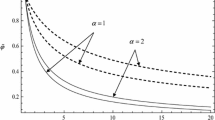Abstract
This paper considers the shock–wave compression of a magnetic field by waves capable of trapping a certain current and transferring it within the shock front. It is shown that this current screens the electromagnetic radiation of the shock front and lowers the efficiency of magnetic compression. An analytical model is proposed that allows one to obtain the spatial distribution and magnitude of shock–induced current for both conducting materials and materials with a shock–induced transition from a nonconducting to a conducting state. It is shown that the current magnitude in conductors is determined primarily by the compressibility of the material, and the magnitude of trapped current is determined by the shock–wave structure and depends primarily on the conductivity of the material, the thickness of the shock front, and the location of the phase transition point within the wave front. In materials with dielectric—conductor transitions, current is entirely concentated inside the shock front, and the current magnitude is determined only by the shock–front structure. It is shown that shock–induced current is accompanied by an anticurrent of the same strength and opposite direction, which spreads over the conducting material surface adjacent to the shock wave, leading to a number of new electrodynamic effects. Decay of a current–carrying shock wave at the interface of materials, which accompanies classical decay of shock–wave discontinuity, is considered. An analysis of the magnetic moments of shock–induced currents shows that for compression of a homogenous magnetic field, the electromagnetic–energy radiation from high–conducting materials is insignificant. However, failure of a conductor involving loss of conductivity in a properly organized rarefaction wave can lead to radiation of a considerable amount of the magnetic field energy accumulated in the conducting material during shock–wave cumulation of the magnetic field.
Similar content being viewed by others
REFERENCES
E. I. Bichenkov, N. G. Skorobogatykh, and A. M. Trubachev, "Magnetocumulative generator,” USSR Inventor's Certificate No. 762706 dated May 16, 1980, Priority November 30, 1978.
E. I. Bichenkov, S. D. Gilev, and A. M. Trubachev, "MC generators using transition of a semiconducting material to a conducting state,” Prikl. Mekh. Tekh. Fiz., No. 5, 125–129 (1980).
K. Nagayama, "New method of magnetic ux compression by means of the propagation of shock induced metallic transition in semiconductor,” Appl. Phys. Lett., 38, No. 2, 109–116 (1981).
E. I. Bichenkov, S. D. Gilev, A. M. Ryabchun, and A. M. Trubachev, "Shock-wave cumulation of a magnetic field. Limiting possibilities of the method,” in: V. K. Chernyshev, V. D. Selemir, and L. N. Plyashkevich (eds.), Megagauss and Megaampere Pulsed Technology and Applications [in Russian], Vol. 1, Inst. of Exp. Phys, Sarov (1997), pp. 121–128.
E. I. Bichenkov, "Structure of the stationary current wave produced by a shock wave in a conducting material with a transverse magnetic field,” Fiz. Goreniya Vzryva, 33, No. 4, 113–127 (1997).
L. D. Landau and E. M. Lifshits, Electrodynamics of Continuous Media [in Russian], GITTL, Moscow (1957).
E. I. Bichenkov, S. D. Gilev, and A. M. Trubachev, "Shock-wave MC generators,” in: Ultrahigh Magnetic Fields. Physics. Technology. Applications, Proc. 3rd Int. Conf. on Megagauss Magnetic Field Generation and Related Topics (Novosibirsk, 1983) [in Russian], Nauka, Moscow (1984), pp. 88–93.
Ya. B. Zel'dovich and Yu. P. Raizer, Physics of Shock Waves and High-Temperature Hydrodynamic Phenomena, Academic Press, New York (1967).
E. I. BIchenkov, "Electromagnetic field and current waves generated by a shock wave entering a conducting sample with a transverse magnetic field,” Prikl. Mekh. Tekh. Fiz., 38, No. 2, 19–25 (1997).
A. A. Barmin, O. A. Mel'nik, A. B. Prishchepenko, et al., "Losses of electromagnetic energy in magnetic-field compression by a shock of the second kind,” Izv. Akad. Nauk SSSR, Mekh. Zhidk. Gaza, No. 6, 166–170 (1988).
Author information
Authors and Affiliations
Rights and permissions
About this article
Cite this article
Bichenkov, E.I. Electrodynamic Effects Accompanying the Propagation of Current–Carrying Shock Waves in a Transverse Magnetic Field. Combustion, Explosion, and Shock Waves 36, 809–815 (2000). https://doi.org/10.1023/A:1002819109831
Issue Date:
DOI: https://doi.org/10.1023/A:1002819109831



